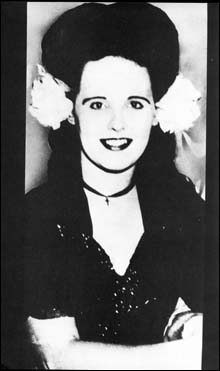She didn’t need an excuse to go out that night.
For the four months she’d been in America, she went out most every weekend night.
But June 21 is Summer Solstice. The Americans might think nothing of it. But back in Sweden, the sun is as high in the sky as it ever gets. The day is a robust 18 hours long. Tradition calls for celebration. Party harder. Drink heavier. Dance longer.
Solstice. Feast of Epona. Litha. Vestalia. Midsommer. When the little girls in Skillingaryd dance around the Maypoles, pick flowers in the meadows, and put them under their pillows so they can dream that night about the man they will one day marry.
For the first part of that night back in 1996, 20-year-old Karina Holmer, who had come to Boston from Sweden to work as a nanny, donned a shiny gray sweater and tight shiny-silver pants, and went to Club Zanzibar on Boylston Place.
There she drank. She danced. She sang. She passed out on the bathroom floor. That was the first half of the night.
The next half of the night she was tortured, killed, and sawed in two. The top half of her body left in a dumpster in the Fenway. The bottom half deposited god knows where.
Karina Holmer came to Massachusetts for a better life and a better party. She wound up in two pieces.
Forty-nine years earlier, Elizabeth Short left Massachusetts for a better life and a better party in Hollywood. She wound up in two pieces too.
Elizabeth Short’s tale is by far the more famous. That’s because Short was the Black Dahlia, titular subject of James Ellroy’s noir classic, of “true Hollywood stories” and “unsolved mysteries.” Dahlia gets fan Web sites, videogames, and an Australian swing band named after her. This week, she’s getting a feature film directed by Brian DePalma with the tagline: “Inspired by the most notorious unsolved murder in California history” (presupposing that we all know OJ killed Nicole and Ron). She gets commercials airing in prime time and a wide release. She gets the fame she was looking for when she first went to Hollywood.
All Karina got was an answer on Jeopardy: “Boston cops were baffled by the murder of Karina Holmer, a Swede working as this French-named type of domestic.”
Stick around and I’ll give you the question.

Elizabeth Short |
From Hollywood
The murder of the Black Dahlia put a chokehold on the darker imaginations of Los Angelenos, who in the late ’40s were just starting to realize that Gary Cooper, Jimmy Stewart, and Jack Webb were not going to save them from the sprawling dystopia their city had become.An unremarkable woman, with just-this-side-of-movie-star looks, Dahlia was a lazy, sickly soul who always dressed in black, hung out in bars and drugstores, and earned her living getting handouts from friends and strangers. She wasn’t a whore (as early accounts portrayed her), but she would bed down with strangers. And if they gave her a few greenbacks, so be it. But in death, she became a legend. The original cautionary tale of Hollywood’s busted dreams (leaving aside the Fatty Arbuckle scandal).
James Ellroy, whose own mother was killed in LA a decade later, calls the Dahlia case “the greatest single unsolved murder in American history” (presupposing that we all know Oswald killed Kennedy).
“Of course we know that such things can happen over there,” Karina Holmer’s sister Johanna told a TV station after the nanny’s murder in 1996, “but it’s nothing that you expect.”
And while Karina’s is certainly not the first cautionary tale of a young European woman going “over there” and getting herself killed (don’t go to Boston, or you’ll end up like that Holmer girl!), her death, followed soon after by the Louise Woodward shaken-baby homicide trial, exposed for a time the lives of young women shipped over to America to care for our children.
Dahlia and Karina belong to a hideous sorority of women who were not merely murdered, but destroyed in such a way that makes rubberneckers slow down traffic for miles. They stand out, searing the collective memory as though the magician’s showstopping trick involving a box, a saw, and “a beautiful girl” had gone horribly wrong.
When their bodies were found, both women had ligature marks on their wrists, suggesting they had been trussed up for torture. Both were washed clean — Karina’s top half was found without the makeup she usually wore out clubbing; Dahlia’s hair was shampooed, washing out her trademark black die to reveal red. Both women’s cuts were quite precise — Dahlia’s sliced neatly between the second and third lumbar vertebrae, Karina’s with only a hiccup at the hip bone.
But the similarities end there.